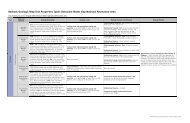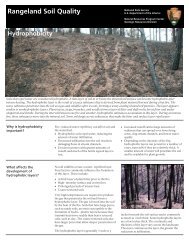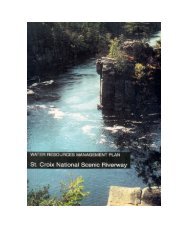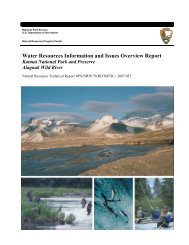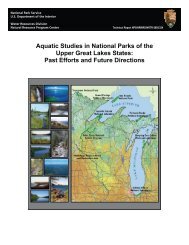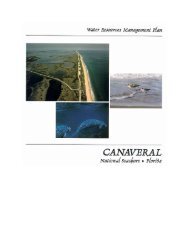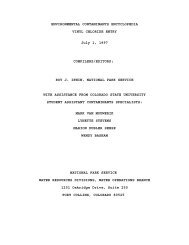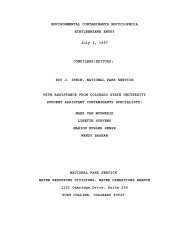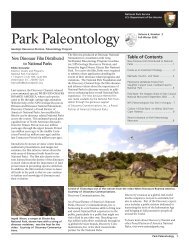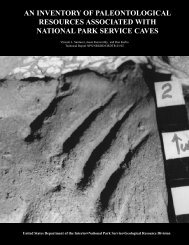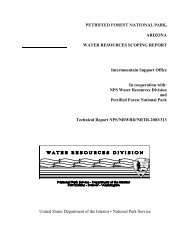Buck Island Reef National Monument Geologic Resources Inventory
Buck Island Reef National Monument Geologic Resources Inventory
Buck Island Reef National Monument Geologic Resources Inventory
You also want an ePaper? Increase the reach of your titles
YUMPU automatically turns print PDFs into web optimized ePapers that Google loves.
<strong>Geologic</strong> Features and Processes<br />
This section describes the most prominent and distinctive geologic features and processes<br />
in <strong>Buck</strong> <strong>Island</strong> <strong>Reef</strong> <strong>National</strong> <strong>Monument</strong>.<br />
<strong>Buck</strong> <strong>Island</strong> is made up of the Upper Cretaceous<br />
Caledonia Formation (map unit symbol Kc) (fig. 14).<br />
Surrounding the island are recent surficial deposits (Qal),<br />
which Whetten (1966) identified as sand, beach rock,<br />
and stream deposits. Uncolonized bedrock (hbub),<br />
colonized bedrock (rcb), and colonized pavement (rcp)<br />
also occur in the immediate vicinity of the island (figs. 15<br />
and 16). “Colonized” is a descriptive term used in the<br />
digital geologic map data for <strong>Buck</strong> <strong>Island</strong>s <strong>Reef</strong> <strong>National</strong><br />
<strong>Monument</strong>. For instance, macroalgae, hard coral,<br />
gorgonians, and other sessile invertebrates colonize the<br />
bedrock and pavement. Seagrass, at varying levels of<br />
“patchiness,” grows primarily to the south of the island,<br />
but patches also occur in the waters to the north of the<br />
island (fig. 17).<br />
A linear reef (rlr) surrounds the east end of <strong>Buck</strong> <strong>Island</strong>,<br />
starting midway on the south side then wrapping<br />
completely around the north side (see front cover photo<br />
and fig. 18). A segment of linear reef also runs southeast/north-west<br />
in the waters at the western end of the<br />
island. Seaward of the main linear reef is a large area of<br />
aggregated patch reef (rpra) (fig. 19). Surrounding and<br />
seaward of the aggregated patch reef are colonized<br />
pavement (rcp) (fig. 16), much with sand channels (rcpc),<br />
and areas of scattered coral or rock in unconsolidated<br />
sediment (rscr) (fig. 20).<br />
Fossils are another geologic resource of interest at <strong>Buck</strong><br />
<strong>Island</strong> <strong>Reef</strong> <strong>National</strong> <strong>Monument</strong>. Paleontological<br />
resources occur in the Caledonia Formation (Kc) and<br />
fossil reefs, which are discussed in the “Paleontological<br />
<strong>Resources</strong>” section.<br />
Caledonia Formation<br />
<strong>Buck</strong> <strong>Island</strong> is composed of the Upper Cretaceous (99.6<br />
million to 65.5 million years ago) Caledonia Formation<br />
(Kc). Although other formations are included on the<br />
digital geologic map for the national monument (see<br />
“<strong>Geologic</strong> Map Data”) and have contributed to the<br />
regional geologic history (see “<strong>Geologic</strong> History”), the<br />
Caledonia Formation is the sole bedrock unit at the<br />
national monument. Beach rock (sand and gravel<br />
cemented with calcium carbonate) might be thought of<br />
as “bedrock,” but Whetten (1966) identified beach rock<br />
as a surficial deposit and mapped it as part of alluvium<br />
(Qal). With respect to the benthic-habitat categories, the<br />
Caledonia Formation is mapped as land (l) by Kendall et<br />
al. (1999).<br />
The Caledonia Formation was named for the wellexposed<br />
outcrops in the Caledonia Valley on<br />
northwestern St. Croix. At the national monument,<br />
exposures occur on the shores of <strong>Buck</strong> <strong>Island</strong>, in<br />
particular the south shore.<br />
About 70 million years ago, the Caledonia Formation was<br />
deposited in a tectonically active, chain of island<br />
volcanoes, called an “island arc.” The formation is<br />
composed of volcaniclastic sediments from a<br />
contemporaneous arc volcano, with lesser amounts of<br />
mud, sand, limestone (skeletal remains of coral), and<br />
chert.<br />
Sediments were deposited via gravity at the base of a<br />
slope of an island arc, specifically the lower slope apron.<br />
Later, fluid-driven processes reworked the sediments via<br />
deep-ocean bottom currents (Stanley 1989). According<br />
to Stanley (1989), most layers of the Caledonia<br />
Formation appear as intermediate between mass-flow<br />
(turbidite) and bottom-current (contourite) deposits in<br />
the rock record. Turbidites originate as turbidity<br />
(density) currents, which can be generated by storm<br />
waves, tsunami, earthquake-induced sliding, tectonic<br />
movement, or an over-supply of sediment (Neuendorf et<br />
al. 2005). In this deep-marine setting below wave base,<br />
thermohaline (deep-water) circulation, not waves, drove<br />
transport and sedimentation of contourites (Stanley<br />
1989).<br />
Geologists estimate that the sequence of events that<br />
culminated in the Caledonia Formation deposited<br />
3,000 m (10,000 ft) (Stanley 1989) to 5,500 m (18,000 ft)<br />
(Whetten 1966) of sediment over 14 million years and<br />
perhaps as long as 30 million years (Speed and Joyce<br />
1989).<br />
Benthic Habitats<br />
In addition to land (l), or the Caledonia Formation (Kc),<br />
Kendall et al. (1999) mapped the seafloor around <strong>Buck</strong><br />
<strong>Island</strong>, separating the substrate into a variety of benthic<br />
habitats. The primary habitats are coral reef and<br />
hardbottom, unconsolidated sediments, and submerged<br />
vegetation (see “<strong>Geologic</strong> Map Data”). According to<br />
Pittman et al. (2008), 78% of all benthic habitat at <strong>Buck</strong><br />
<strong>Island</strong> <strong>Reef</strong> <strong>National</strong> <strong>Monument</strong> is reef and hardbottom,<br />
and 22% is unconsolidated sediment and submerged<br />
vegetation.<br />
<strong>Reef</strong>s<br />
A coral reef is a dynamic, continually changing<br />
environment resulting from by both constructive and<br />
destructive processes. Construction directly depends on<br />
the activity of carbonate-secreting organisms, namely<br />
corals. Also, algae bind loose materials together,<br />
strengthening the reef edifice. When coral and other<br />
carbonate-secreting organisms die, their hard parts are<br />
added to the outer layer of the reef structure, which<br />
sustains the reef’s upward and lateral growth over time.<br />
In this way, the dead marine organisms, which become<br />
BUIS <strong>Geologic</strong> <strong>Resources</strong> <strong>Inventory</strong> Report 19



